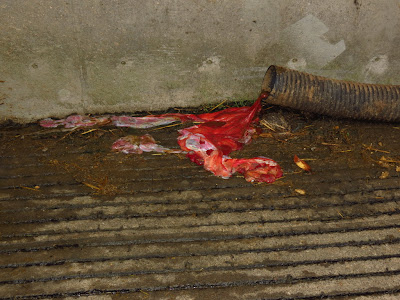Rich Obrist, the third generation owner of the family farm, was so warm and welcoming. When I first talked to Rich on the phone to explain my inquisitive nature he thought maybe I'd buy the farm...he was just joking. Rich led me on a 1 1/2 hour personal tour of the farm, history, successes and problems of farming today.
The Obrist farm was started by Richards grandparents (from Switzerland) in 1920 and Rich has expanded the farm to just under 200 acres and leases some neighboring land.
Every single dairy farm in Tillamook belongs to an association, who all sell their milk to the Tillamook Cheese Factory.
The farm is large and beautiful, as are the cows. The smaller silo's are original and the larger one, while still good, are obsolete. They can store and move grain much faster nowadays with tractors and trucks.
I'll start with the babies. Rich crosses Holsteins and Guernseys in an attempt to increase fat content with quantity. The Holsteins are much larger and produce more milk while the Guernsey's are smaller and eat less but produce higher fat content for the cheese factory. Rich only keeps the female babies, the males are picked up twice a week and he is paid around $35 each.
Within 5 minutes of meeting Rich I am reminded of my younger brother who has a real soft spot in his heart for all of gods creatures. His cat Charley, a stray, follows him like a child while his treatment and talk of his cows shows his concern for their health. The ear tag tells us the date she was born and she is the 337th born since January 1st 2012
The two week old babies are kept in clean separate stalls for a month then sent to another farm of Rich's for the next few months to mature. In the back of the stall was this little kitten...or mouser.
After a year or so the heifers are brought back to the farm to be inseminated which is strictly controlled with PC records. These gals are not to far away from being impregnated.
Here was a herd of about 30 moms in varying stages of childbirth. Some were hours away, some a few days away. Rich keeps them separate because he knows if they should have a calf without the farm hands knowing about it, the other mothers tend to help any 1st year heifer. The farm might have an average of 5 calves a week. The brown heifer is one of the Guernseys and only hours away from a birth.
It may be a little gross but Rich likes to get the afterbirth away from the mothers because some have choked in the past while cleaning the calf.
Ok...lets get down to business. A dairy farm survives by selling milk and this utter is what it's all about!
I'd had always heard that the dairy farmer gets up early in the morning to milk the cows...BS! I didn't know that they are milked TWICE a day, at 1:30 AM and then again at 1:00 pm. Each milking takes 5 hours for the 600 milk bearing heifers.
The milking barn is kept very clean and the utters are washed before being pumped. The average cow might produce 10 to 15 gallons a day for 10 months and then are giving 60 days off...that's more vacation time than I had after 20 years! Unfortunately they only last 5 or 6 years doing this.
This lady is wishing they would preheat the teat pumps!
The cows each have their own stall if they wish to use it. If the weather permits, they might be out in the pasture but otherwise they have enough stalls for all.
The feed runs from grass, alfalfa, grain, corn silage to a fermented grass that is popular in the winter.
While the girls are in the milk barn doing their thing...one of the 20 or more employee's loads feed into their stalls so the milk production can start all over again..
Rich grows his own grass, buys grain and has a 300 acre ranch in Eastern Oregon to grow the alfalfa they need.
I was surprised at how many pieces of heavy equipment, trucks, front end loaders and tractors it took to make this farm viable.
The family home shows it's Swiss roots by the manicured and organized grounds.
Many thanks to Rich and the Obrist family for all their hospitality.




















1 comment:
Post a Comment